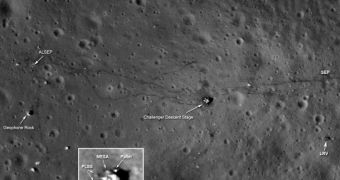Officials at the American space agencies have just released several new high-resolution photos of a number of Apollo landing sites. The batch of images was made available yesterday, September 6, and many of them show the disposition of equipment that was left behind on the Moon.
The datasets were collected by the NASA Lunar Reconnaissance Orbiter (LRO), which has been studying Earth's natural satellite for a couple of years now. This is not the first time that the spacecraft has imaged lunar landing sites, but the new photos are the most detailed to date.
Instruments aboard the LRO are so precise that they can even snap images of tracks left behind as NASA astronauts were traveling on the lunar surface aboard their rovers. Given the atmospheric conditions on the Moon, the tracks will still remain visible for many years.
In order to zoom in close to the three landing sites, LRO mission controllers decided to use the orbiter's narrow-angle camera. This is the same instrument that is widely used to study craters or openings in the lunar surface, such as for example those that lead to caves.
“The images look very spectacular, as you can see for yourself,” LRO Camera principal investigator Mark Robinson said in a briefing yesterday. He holds an appointment as a research scientist at the Arizona State University (ASU), in Tempe.
He also pointed out the differences between the tracks left behind by astronauts and those produced by their rovers. Small-scale details about the vehicles can also be observed with a little bit of effort.
You “can actually see, if you squint really hard – can begin to resolve the seats and the left wheels that are slightly turned to the left,” the expert said of the lunar rover at the Apollo 17 landing site. The footprints left behind by Eugene Cernan and Harrison Schmitt can be distinguished as well.
The other two sites that were imaged are those of Apollo 12 and Apollo 14. The images were collected in a bid to gain a better understanding of how these missions went, as well as on the impacts they had on the lunar environment.
“From a science standpoint, [the images] are important for two reasons. They tell us something about the photometric properties of the Moon – why are they darker?” Robinson explained yesterday.
“Scientists are working to investigate that question. In a more practical sense, it allows us to find the exact spot where samples were collected,” he added. “I've looked around, and all I really see are the spots where the flag was planted,” the investigator explained, as quoted by Space.
These images come just two days ahead of a planned September 8 launch, which will see the GRAIL mission taking off for the Moon. The purpose of the twin spacecraft will be to analyze the satellite's interior, in order to determine its structure and how it evolved.

 14 DAY TRIAL //
14 DAY TRIAL //